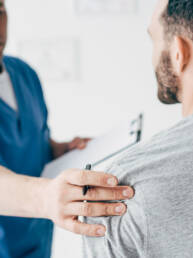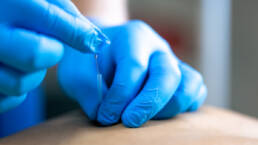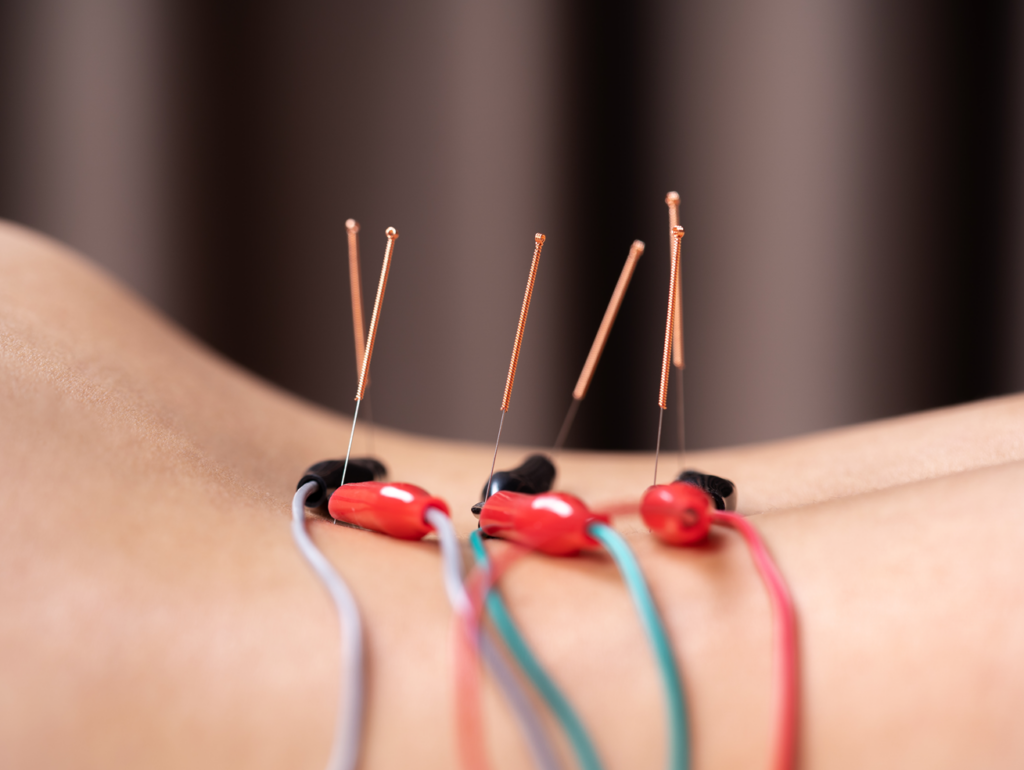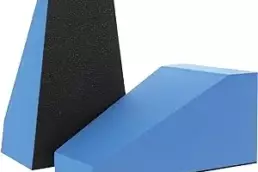When considering receiving Acupuncture vs Dry Needling, it’s important to know the facts. Dry needling is considered a medical treatment using needles to stimulate trigger points, which are basically small bundles of tight muscles. Trigger points can cause headaches, muscle cramps, and joint pain. Dry needling helps to release the tension in the trigger points and relieve pain.
At first, it can be hard to tell the difference between dry needling and acupuncture. Both treatments use thin, stainless steel needles inserted into the skin.
However, that’s where the similarities cease. There are specific things that separate these two types of treatment. People have used acupuncture to treat illnesses and injuries for thousands of years. There is more published research on the benefits of acupuncture than dry needling. However, this is because acupuncture has a more longer history.
Acupuncture relieves pain and improves function by inserting needles at specific points in the body. Dry needling involves inserting those same needles into trigger points or localized areas of muscle spasm.
Knowing the difference between these two types of treatment can help you decide which treatment is best for you.
Table of Contents
ToggleWhat Exactly is Dry Needling?
Dry needling uses some of acupuncture’s techniques in a more “medical” way. Unlike acupuncture, dry needling consists of inserting acupuncture needles into areas determined by anatomy (usually trigger points) instead of the “channels” or “meridians” used in acupuncture. In fact, the needles used in dry needling are acupuncture needles. Unlike a hypodermic needle, acupuncture needles are very narrow, solid, needles. Acupuncture needles don’t inject anything into the tissue, which is why it’s called “dry” needling. A trigger point is a small bundle of muscle fibers that are “stuck” together. Trigger points typically form when muscles are tight for long periods and develop “adhesions” or scar tissue.
Dry needling tries to relax the tight muscles. By reducing the muscle knot, patients experience less pain and greater ranges of motion. The needles used in dry needling can be left in the muscle for a few minutes or just a few seconds. The length of time depends on what the Doctor is trying to do.
Why is it Called Dry Needling?
Dry Needling uses a solid, monofilament needle inserted into soft tissue. This needle’s diameter typically ranges from .15mm to .35mm (much smaller than a wet needle). It can result in some post-needling soreness or leave some mild bruising.
Wet Needling uses a hollow bore needle that is required to deliver injectables (fluid) like corticosteroids, anesthetics, or other substances. The needle diameter is typically much larger than a dry needle (.5mm to 1mm)
Whenever medication is added to the treatment, the likelihood of side effects like skin discoloration or tissue damage increases. Dry Needling does not produce significant side effects like these.
“Sparrow Pecking” Needling Technique
A widespread dry needling technique is pistoning or “sparrow pecking.” This technique involves inserting the acupuncture needle “in-and-out”. In other words, the needle doesn’t stay inserted at a standard depth.
Instead, The needle is inserted into the tissue and pulled back toward the skin’s surface. Sparrow pecking does not remove the needle. The acupuncture needle is drawn to a lesser depth in the muscle and then pushed back in. This action is to get a response from the spasmed muscle.
Non-Trigger Point Techniques
Some dry needling techniques treat conditions not related to muscle spasms. This “non-trigger point” treatment is more closely related to Acupuncture. Instead of only inserting needles in areas of pain, they are also inserted near the complaint site.
The non-trigger point method treats pain related to nerves outside the area of muscle tightness. It doesn’t just focus on the main area of pain.
Dr. Doran is a Certified Chiropractic Acupuncturist also trained in dry needling. The American Medical Association (AMA) considers Acupuncture and dry needling invasive procedures. Like all treatments for your health, you should only seek treatment from an experienced Doctor.
What Does Dry Needling Feel Like?
Muscle Twitch: It can mean that the muscle tension has been reduced!
Deep Dull Ache: Indicates your Clinician is stimulating tissue that needs it, which is good as long as it slowly reduces and does not increase.
Burning: indicates the needle is close to a skin nerve called a C-fiber, a pain sensor. Don’t worry; just let your Clinician know, and they will remove it and rub your skin, and there will be no lasting issues.
Tingling: can indicate you are close to nervous tissue, which is safe and, many times, is the goal to reduce inflammation and, ultimately, your pain.
Reproduction of your pain: if the needling reproduces your specific pain, believe it or not, it can be a good thing! If your Clinician knows precisely where the pain is coming from, it is easier to treat it!
Always let your Clinician know what you are feeling; the treatment can be modified to achieve the best results!
Dry needling is an invasive procedure that, when performed appropriately, should only cause minor short-term discomfort, if any, and should not be considered painful.
Needle placement is commonly associated with a twitch response (muscle jumps reflexively) or deep, dull achiness that should dissipate rather quickly.
What Are the Benefits of Dry Needling?
Dry needling relieves tight muscles which helps to reduce joint pain and stiffness. Treating trigger points can improve your flexibility and increase range of motion. Dry needling can be used to treat sports injuries, muscle pain, and even fibromyalgia.
- Improved blood flow
- Release of muscle tension
- Decreased pain
- Increased range of motion
- Increased muscle strength
- Improved function
What Does Research Say About Dry Needling?
While there is a growing number of studies supporting dry needling, there is a large amount of research on Acupuncture. Right now, there is less research on dry needling because it is a newer type of treatment than acupuncture.
What Are the Side Effects of Dry Needling?
Some mild side effects can occur with dry needling. However, more serious side effects from dry needling are very rare. The most common side effects from dry needling include:
- Fatigue/drowsiness
- Mild bruising/ bleeding
- Short-term increase in symptoms
- Muscle soreness after needling
- Syncope (fainting, very rare)
- Temporary muscle soreness
Of course, using nonsterile needles has risks. These risks include infection, contracting bloodborne illnesses, and even disease. Dr. Doran only uses “single-use” acupuncture needles placed in a specialized “sharps container” after use. When receiving dry needling, ensure your provider uses sterile acupuncture needles and disposes of them after each use.
Another possible but very minor risk of dry needling is a pneumothorax. If a needle is placed too deeply in or around the lungs, the tiny hole can cause your lung to collapse. The possibility of injury is another reason to choose an experienced provider. Dr. Doran has been a Certified Chiropractic Acupuncturist since 2004. He has hundreds of hours of training in this field and decades of experience treating patients.
What is Acupuncture?
Acupuncture is a medical treatment used for hundreds — even thousands — of years. Acupuncture originated in Asia thousands of years ago. Its core belief is based on the theory that “Qi” or “Life Energy” flows throughout the body through “channels” or “meridians.” When there is a blockage of this energy, that is where pain, illness, and disease begin. Using needles to restore this normal energy flow restores the patient’s health.
What Are the Benefits of Acupuncture?
Research shows that both types of needling have many benefits. Acupuncture and dry needling increase blood flow, removing toxins and bringing glucose and oxygen to injured and damaged tissues. Needles also provide competing, non-painful stimulus to areas of pain. Lastly, needling areas of muscle spasm can actually cause the muscles to relax.
Dr. Doran has had success using Acupuncture to treat many different conditions and symptoms, including:
- Shoulder injuries
- Headaches
- Vertigo
- Sports injuries
- Lower back pain
Acupuncture has also been successfully used to treat alcohol, drug, and nicotine addiction.
Is There Research on Acupuncture?
Acupuncture treats several types of pain. Here’s what the research says.
Low Back Pain
A meta-analysis published in 2022 showed that Acupuncture (specifically electroacupuncture) effectively treated lower back pain. Additional studies found that acupuncture provides short-term relief from low back pain. Combining Acupuncture with other treatments like chiropractic adjustments, laser therapy, and shockwave therapy often gets the best results in relieving pain.
Knee Pain
Knee pain from osteoarthritis is the leading cause of disability in adults in the United States. Another review of research studies in 2010 showed how Acupuncture helps treat this widespread condition.
Neck Pain
Research shows that Acupuncture greatly reduces neck and back pain. It eases and relieves pain, lessens muscle tightness, and works best with other treatments like chiropractic, laser therapy, and shockwave therapy. Acupuncture and chiropractic adjustments treat the cause of neck pain instead of simply masking the symptoms like drugs do.
Migraines and Headaches
A review of published studies on Acupuncture and migraines found Acupuncture to be as effective at relieving migraine symptoms as other treatments, including prescription and over-the-counter (OTC) medications. It also has benefits over classic treatments, including longer-lasting effects, lower medication use, and fewer severe complications or side effects. Additionally, regular acupuncture treatments may help people with a history of migraines prevent future episodes.
Labor pains
Research has shown that Acupuncture can even help reduce labor pains during childbirth. Studies have shown significant reductions in pain.
Smoking cessation
Acupuncture has shown some benefits in helping people to stop smoking. While research hasn’t established Acupuncture as a completely effective way to quit smoking, Dr. Doran has seen it as a helpful addition to other types of treatment. Nicotine replacement products combined with Acupuncture are more effective than nicotine products alone.
Depression
One published study looked at Acupuncture and antidepressant medication to ease signs of depression. It found that medication combined with Acupuncture was a well-tolerated treatment with few complications. The combination allowed for lower doses of medication to produce better effects.
What Are the Side Effects of Acupuncture?
When performed by a trained and licensed provider, side effects and risks are rare. Occasionally, someone may experience:
- Pain at the insertion site
- Bruising at the insertion site
- Bleeding at the insertion site
Pain from dry needling, like with Acupuncture, typically results from inserting a needle into a spasmed or tight muscle. Bruising is rare and usually very minor. Most often, bruises result from a needle hitting a small blood vessel. The bruises from needling are very rarely painful or even uncomfortable.
Acupuncture vs Dry Needling: Which is Better?
Research has shown both acupuncture and dry needling to be useful for treating knee pain caused by arthritis.
Non-trigger point dry needling provided more relief than treating “traditional” dry needling points. A 2014 research review shows that dry needling the tissues around the area of knee pain was more effective than needling just at the point of pain. Treating “non-trigger” points is similar to Acupuncture, treating a broader body area and not focusing on only painful areas.
How Do I Choose Acupuncture vs Dry Needling?
Talk to your doctor to choose between Acupuncture and dry needling. An experienced practitioner will have a good idea of what is best for you. The cause of your complaint, previous health history, and the initial exam results all help determine the best treatment for you.
“Pros” of Acupuncture vs Dry Needling
- Acupuncture may be effective for treating pain, nausea, and other symptoms.
- Both treatments are safe procedures with few side effects.
- Acupuncture needles are considered a safe and effective treatment with thousands of years of documented use.
- Research shows that acupuncture and dry needling effectively treat pain, muscle spasms, and other symptoms.
- It is a relatively safe procedure with few side effects.
Ultimately, your best treatment will depend on your needs and preferences.
“Cons” of Acupuncture vs Dry Needling
- There can be some mild side effects like bruising or bleeding.
- Most scientific evidence supports Acupuncture but can be correlated to Dry Needling.
- Both dry needling and Acupuncture can be uncomfortable. Needling tight or spasmed muscles can be painful, especially in areas of tight or spasmed muscles.
How Do I Decide Acupuncture vs Dry Needling?
Your budget: The prices of Acupuncture and Dry Needling can vary, so ask for an estimate of what your treatment will cost for both.
Your insurance coverage: Your plan may or may not cover Acupuncture vs Dry Needling. It’s best to confirm your insurance coverage before starting. Integrative Health and Rehab has a very affordable discount program for those without insurance or acupuncture/dry needling coverage.
Your pain tolerance: Dry needling can be more painful than Acupuncture. While not “excruciating,” it can be unpleasant.
Your cultural preferences: Acupuncture is a traditional Chinese medicine (TCM) practice, so you may prefer it if you are interested in TCM. If you are still determining which treatment is right for you, schedule a FREE consultation with Dr. Doran to determine if Acupuncture vs Dry Needling is best for you.
Still have questions Acupuncture vs. Dry Needling? Contact us! Still not sure? Read some of our 5-Star Google reviews and see what patients have to say. We’ve been helping patients in Arvada, North Denver, and Wheat Ridge, Colorado, for over 20 years. Lastly, learn more about the conditions we treat and the benefits of the many types of treatment we provide on our Health Articles page. Ready to start feeling better? Looking for a Chiropractor in Denver? Book an appointment online!

Ready for an expert opinion? Get in touch today!
With a legacy of more than 25 years, our team specializes in helping individuals triumph over back pain, neck discomfort, and persistent headaches, all without relying on addictive medications or risky surgical procedures.







